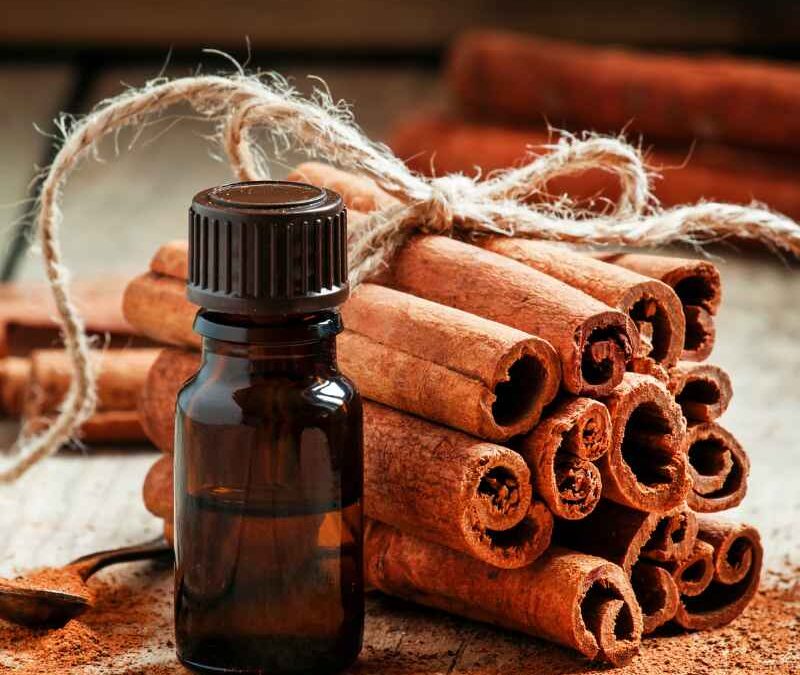Unlocking The Power Of Cinnamon Bark Essential Oil: Cinnamon Leaf VS. Cinnamon Bark Essential Oil
Have you ever been captivated by the rich and warm scent of cinnamon? This beloved spice has a long history, and its essential oils, specifically Cinnamon Bark and Cinnamon Leaf, are gaining popularity for their therapeutic properties. In this article, we’ll explore these two aromatic gems, highlighting their differences, similarities, and various uses.
The Allure of Cinnamon: An Overview
Cinnamon has been cherished throughout history for its enticing fragrance and culinary uses. But did you know that this aromatic delight is also distilled into essential oils? Let’s start by understanding what these essential oils are and how they are obtained.
Essential Oils 101:
- Essential oils are concentrated, volatile compounds extracted from aromatic plants.
- They capture the plant’s unique scent and therapeutic properties.
- Extraction methods include steam distillation, cold-pressing, and CO2 extraction.
Cinnamon Bark Essential Oil
Definition and Characteristics
Cinnamon Bark Essential Oil is derived from the bark of the Cinnamomum verum tree, also known as “true cinnamon.” It’s known for its deep, spicy, and sweet aroma.
Key Characteristics:
- Aroma: Rich, warm, and spicy.
- Color: Deep brownish-yellow.
- Consistency: Thick and viscous.
Extraction Process and Sustainability
- Steam distillation of the bark.
- Sustainability is a concern due to overharvesting; look for sustainably sourced oils.
Chemical Composition and Therapeutic Properties
- Primary component: cinnamaldehyde.
- Therapeutic properties: antibacterial, antifungal, warming, and stimulating.
Popular Uses and Applications
- Diffusion for a cozy, inviting ambiance.
- Topical application (diluted) for muscle pain relief.
- A warming addition to skincare products.
Safety Considerations and Precautions
- Highly concentrated, so always dilute before use.
- Potential skin sensitivity; do a patch test.
- Avoid use during pregnancy.
Cinnamon Leaf Essential Oil
Definition and Characteristics
Cinnamon Leaf Essential Oil comes from the leaves of the Cinnamomum zeylanicum tree and has a slightly different aroma compared to the bark oil.
Key Characteristics:
- Aroma: Spicy, but milder and sweeter than bark oil.
- Color: Yellow to brown.
- Consistency: Thin and watery.
Extraction Process and Sustainability
- Steam distillation of the leaves.
- Leaf oil is more sustainable due to faster regeneration.
Chemical Composition and Therapeutic Properties
- Dominated by eugenol, which has anti-inflammatory properties.
- Therapeutic properties: antiseptic, analgesic, and digestive aid.
Popular Uses and Applications
- Milder scent makes it ideal for diffusing in smaller spaces.
- Topical use (diluted) for muscle and joint discomfort.
- Can soothe digestive issues when properly diluted and used.
Safety Considerations and Precautions
- Dilute before skin application.
- Avoid during pregnancy.
Cinnamon Bark vs. Cinnamon Leaf Essential Oil
Scent and Aroma Comparison
- Cinnamon Bark: Rich and spicy.
- Cinnamon Leaf: Milder and slightly sweeter.
Therapeutic Benefits and Uses: Similarities and Differences
- Both have antibacterial properties, but the bark oil is stronger.
- Cinnamon Leaf is gentler on the skin due to its milder nature.
Blending with Other Essential Oils
- Bark oil combines well with cloves, citrus oils, and ginger.
- Leaf oil blends seamlessly with lavender, frankincense, and other spice oils.
Selecting the Right One for Your Needs
- Choose Cinnamon Bark for its robust, spicy scent and potent properties.
- Opt for Cinnamon Leaf if you prefer a milder aroma or have skin sensitivity.
Potential Health Benefits
Cinnamon essential oils offer various health benefits, including:
- Antimicrobial properties: They can help combat infections and bacteria.
- Anti-inflammatory effects: Useful for reducing muscle and joint discomfort.
- Stress relief: The warm scent can be soothing and comforting.
Research and studies support these benefits, making these oils a valuable addition to your aromatherapy toolkit.
How to Use Cinnamon Bark and Cinnamon Leaf Essential Oils
Detailed Usage Guidelines and Applications
- Diffusion: Add a few drops to your diffuser for a warm and inviting atmosphere.
- Topical Application: Dilute with a carrier oil and apply to sore muscles or joints.
- Skin Care: Incorporate into your skincare routine for added benefits.
DIY Recipes for Beauty, Wellness, and Home Applications
Warm and Cozy Cinnamon Bark Diffuser Blend:
Ingredients:
Instructions:
- Fill your diffuser with water according to the manufacturer’s instructions.
- Add the specified number of drops of each essential oil to the water.
- Turn on your diffuser and let it disperse the aromatic blend throughout your space.
This blend combines the warmth of cinnamon with the sweet and citrusy notes of orange and the spiciness of clove. It’s perfect for creating a cozy and comforting ambiance, especially during the fall and winter seasons. Enjoy the delightful fragrance and the potential therapeutic benefits it offers.
Homemade Immune-Boosting Thieves Essential Oil Blend:
Ingredients:
- 40 drops of Clove essential oil
- 35 drops of Lemon essential oil
- 20 drops of Cinnamon Bark essential oil
- 15 drops of Eucalyptus essential oil
- 10 drops of Rosemary essential oil
Instructions:
- Using a glass dropper, add the specified number of drops of each essential oil to a dark glass bottle. Make sure the bottle is clean and dry.
- Tightly seal the bottle with a cap or dropper lid.
- Gently roll or shake the bottle to mix the essential oils thoroughly.
- Label the bottle with the name and date of the blend for easy identification.
To use the Thieves-inspired blend:
- You can diffuse it: Add a few drops to your essential oil diffuser to purify the air and create a germ-fighting atmosphere.
- Topical application: Dilute a few drops of the blend with a carrier oil (such as jojoba, coconut, or sweet almond oil) and apply it to your wrists, the soles of your feet, or the back of your neck.
- Household cleaning: Add a few drops to a spray bottle filled with distilled water and use it as a natural surface cleaner. DIY Thieves cleaner recipe
This blend combines the antibacterial, antiviral, and immune-supporting properties of the individual essential oils. It’s a versatile and aromatic way to support your immune system and maintain a clean, fresh environment. Always remember to do a patch test if you plan to use it on your skin, and consult a healthcare professional if you have any concerns or underlying health conditions.
Bathroom Air Freshener Spray:
Ingredients:
- 2/3 cup distilled water
- 1/3 cup witch hazel
- 10-15 drops Cinnamon Bark essential oil
- 10-15 drops Orange essential oil
- 5-10 drops Ginger essential oil
- A small spray bottle
Instructions:
- Start by choosing a clean, empty spray bottle. Ensure it’s thoroughly cleaned and completely dry.
- In a glass measuring cup, combine the distilled water and witch hazel.
- Add 10-15 drops of Cinnamon Bark essential oil, 10-15 drops of Orange essential oil, and 5-10 drops of Ginger essential oil to the liquid mixture. Adjust the number of drops to achieve the desired strength of the blend. Start with fewer drops and add more if necessary.
- Stir the mixture thoroughly to ensure even distribution of the essential oils.
- Using a funnel, carefully pour the mixture into your empty spray bottle.
- Secure the spray bottle with its nozzle or cap.
- Label the bottle with the contents and usage instructions.
Usage:
Shake the bottle gently before each use to ensure the essential oils are well mixed. Spray the air freshener as needed in your bathroom. Be mindful not to overspray, as the combined scents of cinnamon, orange, and ginger can be quite potent. A little goes a long way.
This homemade air freshener spray will help eliminate odors in your bathroom while filling the space with a warm, invigorating aroma. Just as with any essential oil product, store it out of the reach of children and pets, and avoid direct contact with your eyes and skin. Enjoy the delightful blend!
Safety Precautions
Important Safety Tips for Using Essential Oils
- Always dilute before applying to the skin.
- Perform a patch test to check for sensitivity.
- Keep out of reach of children and pets.
Special Considerations
- Pregnant individuals should avoid using both oils.
- Use caution, as these oils are potent.
Where to Buy and Quality Assurance
When shopping for essential oils, it’s crucial to select high-quality products. Here are some tips:
- Look for oils that are 100% pure and free from additives.
- Check for third-party testing and quality certifications. (GCMS testing)
- Purchase from reputable brands and suppliers.
- Read customer reviews
Conclusion
Cinnamon Bark and Cinnamon Leaf Essential Oils offer a wealth of aromatic and therapeutic benefits. Whether you’re drawn to the rich, spicy scent of the bark oil or the milder, sweet notes of the leaf oil, both can enhance your well-being and elevate your aromatherapy experiences. Use them wisely, and savor the warmth of cinnamon in your life.
Have fun creating a life that naturally makes scents!
Read Next:
Learn More:
The information provided here is intended for educational purposes only and is not a substitute for professional medical advice, diagnosis, or treatment. Essential oils are potent natural compounds that can offer various benefits when used appropriately.
Some of the links on this website are affiliate links, which means that we may earn a commission if you click on the link or make a purchase using the link. When you make a purchase, the price you pay will be the same whether you use the affiliate link or go directly to the vendor’s website using a non-affiliate link. By using the affiliate links, you are helping support our website, and we genuinely appreciate your support.




